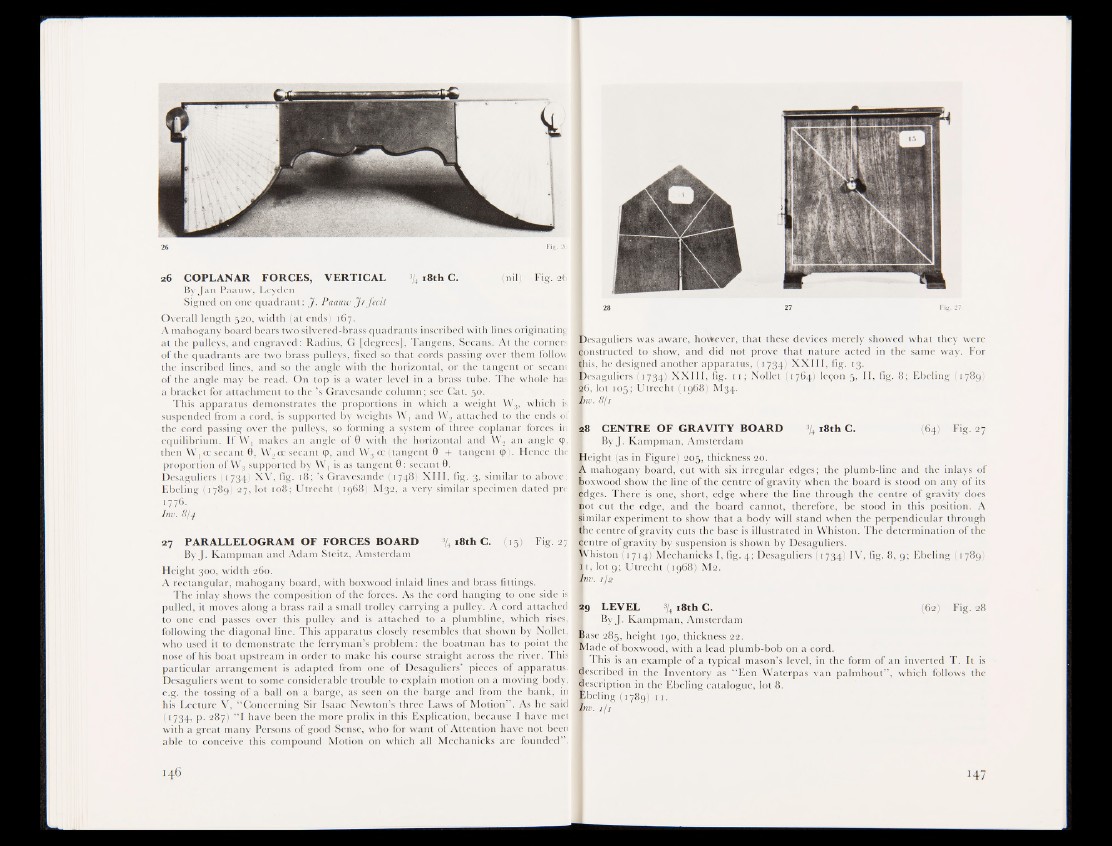
26
26 COPLANAR FORCES, VERTICAL % 18th C. (nigfc Fig. 26
By Jan Paauw, Leyder^M
Signed on one quadrant: J. Paauw Jr fecit
Overall length 520, width (at endsH|i67.
A mahogany board bears two silvered-brass quadrants inscribed with lines originating
at the pulleys, and engraved: Radius, G |degrees], Tangens, Secans. At the corners
of the quadrants ..are two brass pulleys, fixed so that cords passing over them follow
the inscribed lines, and so the angle with the horizontal, or the tangent or secant
of the angle may be read. On top is a water level in a brass tube. The whole has
a bracket for attachment to the’s Gravesande column; see Cat. 50.
This apparatus demonstrates the proportions in which a weight W3, which is
suspended from a cord, is supported by weights W, and W2 attached to the ends of
the cord passing over the pulleys, so forming a: system three coplanar foreeilin
equilibrium. If Wj makes an angle of 0 with the horizontal and W2 an angle cp,
then W^oc secant 0, W2oc secant cp, and W3 oc (tangent 0 + tangent cp). Hence the
proportion of W3 supported by W j is as tangent 0 : Scant 0.
Desaguliers (1734) XV, fig. 18; ’s Gravesande (1748) XIII, f i f i j , similar to above;
Ebeling (1789) 27, lot 108; Utrecht (1 g68| M32, a very similar specimen dated pre
1776.
Inv. 8I4
27 PARALLELOGRAM OF FORCES BOARD ■ jli8thC. I f 15) Fig. 27
By J. Kampman and Adam Steitz, Amsterdam
Height 300, width 260.
A rectangular, mahogany board, with boxwood inlaid lines andfeass fittings.
The inlay shows the composition of the forces. As the cord hanging to one side is
pulled, it rrïovés along a brass rail a small trolley carrying a pulley. A cord attached
to one end passes over this pulley and is attached to a plumbline, which rises,
following the diagonal line. This apparatus closely resembles that shown by Nollet,
who used it to demonstrate the ferryman’s problem: the boatman has to point the
nose of his boat upstream in order to make his course straight across the river. This
particular arrangement is adapted from one of Desaguliers’ pieces of apparatus.
Desaguliers went to some considerable trouble to explain motion on a moving body,
e.g. the tossing of a ball on a barge, as seen on the barge and from the bank, in
his Lecture V, “ Concerning Sir Isaac Newton’s three Laws of Motion” . As he said
(1734, p. 287) “ I have been the more prolix in this Explication, because I have met
with a great many Persons of good Sense, who for want of Attention have not been
able to conceive this compound Motion on which all Mechanicks are founded” .
28 27 Fig. 27
Desaguliers was aware, however, that these devices merely showed what they were
constructed to show, and did not prove that nature acted in the same way. For
Shis, he designed another apparatus,, (1734) XXIII, fig. 13.
Desaguliers ( 1734) XXIII, fig. 11 ; Nqllet;|r 764) leçon 5, II, fig. 8; Ebeling (1789)
16, lot 105; Utrecht (1968) M34.
Inv. 8]1
28 CENTRE OF GRAVITY BOARD 18th C. (64) Fig. 27
ByJ. Kampman, Amsterdam
Height (as in Figure) 205, thickness 20.
À mahogany board, cut with six irregular edges; the plumb-line and the inlays of
æoxwood show the line of the centre of gravity when the board is stood on any of its
IdgSs. There is one, short, edge where the line through the centre of gravity does
snot cut the edge, and the board cannot, therefore, be stood in this position. A
similar experiment to show that a body will stand when the perpendicular through
the centre of gravity cuts the base is illustrated in Whiston. The determination of the
lentre of gravity by suspension is shown by Desaguliers.
■ Vhiston (1714) Mechanicks I, fig. 4; Desaguliers (1734) IV, fig. 8, 9; Ebeling (1789)
f 1, lot 9; Utrecht (1968) M2.
inv. rjh
29 LEVEL s/4 18th C. (62) Fig. 28
ByJ. Kampman, Amsterdam
Base 285, height 190, thickness 22.
Made of boxwood, with a lead plumb-bob on a cord.
I This is an example of a typical mason’s level, in the form of an inverted T. It is
described in the Inventory as “ Een Waterpas van palmhout” , which follows the
lescription in the Ebeling catalogue, lot 8.
Ebeling :( 1789) 11.
mv. i j j